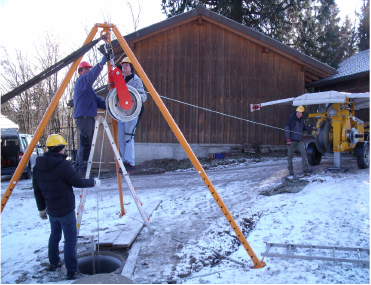Deichmann, N., Kraft, T. and Evans, K.F. (2014). Identification of faults activated during the stimulation of the Basel geothermal project from cluster analysis and focal mechanisms of the larger magnitude events. Geothermics 52, 84-97. doi: 10.1016/j.geothermics.2014.04.001
Diehl, T., Kraft, T., Kissling, E., Deichmann, N., Clinton, J. and Wiemer, S. (2014). High-precision relocation of induced seismicity in the geothermal system below St. Gallen (Switzerland). EGU General Assembly Conference Abstracts 16, 12541.
Edwards, B., Kraft, T., Cauzzi, C., Kastli, P. and Wiemer, S. (2015). Seismic monitoring and analysis of deep geothermal projects in St Gallen and Basel, Switzerland. Geophys. J. Int. 201, 1020-1037.
Evans, K.F., Zappone, A., Kraft, T., Deichmann, N. and Moia, F. (2012). A survey of the induced seismic responses to fluid injection in geothermal and CO2 reservoirs in Europe. Geothermics 41, 30-54. doi: 10.1016/j.geothermics.2011.08.002
Goertz, A., Riahi, N., Kraft, T. and Lambert, M. (2012). Modeling Detection Thresholds of Microseismic Monitoring Networks. 2012 SEG Annual Meeting. Society of Exploration Geophysicists.
Kraft, T., Mignan, A. and Giardini, D. (2013). Optimization of a large-scale microseismic monitoring network in northern Switzerland. Geophysical Journal International 195, 474-490. doi: 10.1093/gji/ggt225
Kraft, T., Wiemer, S., Deichmann, N., Diehl, T., Edwards, B., Guilhem, A., Haslinger, F. et al. (2013). The ML 3.5 earthquake sequence induced by the hydrothermal energy project in St. Gallen, Switzerland. AGU Fall Meeting Abstracts 1, 3.
Kraft, T. and Deichmann, N. (2014). High-precision relocation and focal mechanism of the injection-induced seismicity at the Basel EGS. Geothermics 52, 59-73. doi: 10.1016/j.geothermics.2014.05.014
Kraft, T. (2015). A high-resolution ambient seismic noise model for Europe. EGU General Assembly Conference Abstracts 16, 12407.
Kraft, T. et al. (2015). Lessons learned from the 2013 ML3.5 induced earthquake sequence at the St. Gallen geothermal site. Schatzalp Workshop on Induced Seismicity, Davos, Switzerland.
Obermann, A., Kraft, T., Larose, E. and Wiemer, S. (2015). Potential of ambient seismic noise techniques to monitor the St. Gallen geothermal site (Switzerland). J. Geophys. Res. Solid Earth 120(6), 4301–4316. doi: 10.1002/2014JB011817
Plenkers, K., Husen, S. and Kraft, T. (2015). A Multi-Step Assessment Scheme for Seismic Network Site Selection in Densely Populated Areas. Journal of Seismology 19(4), 861-879.
